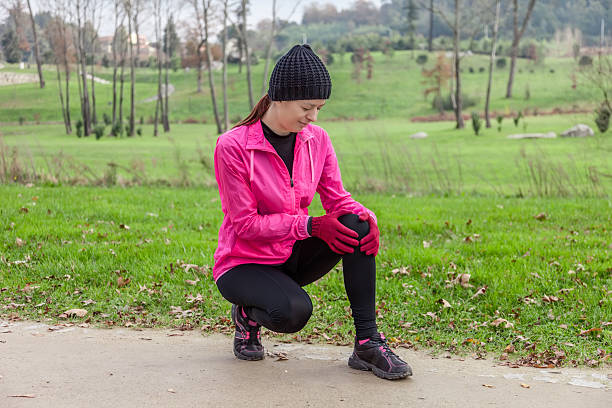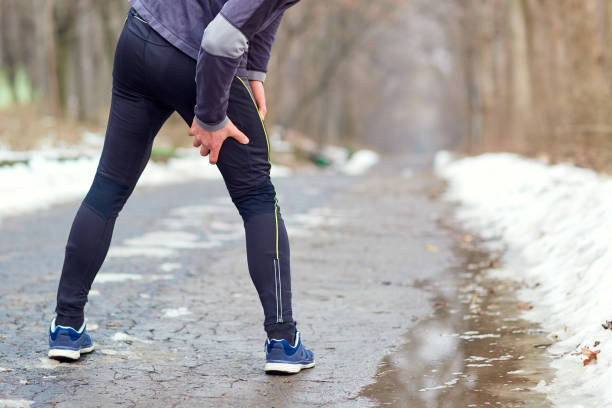Joint Health
How To Prevent Joint Pain In Cold Weather
Many of us have joint stiffness and aches as the temperature decreases, making it difficult to enjoy the winter season. Cold temperatures can aggravate pre-existing joint problems like arthritis and induce discomfort in otherwise healthy joints. Fortunately, there are things we can do to lessen the risk of joint pain and stay warm during the winter.
Staying warm is one of the most important recommendations for avoiding joint pain in cold weather. Layering clothing and wearing warm clothing can help keep joints from stiffening and becoming uncomfortable. Gloves, scarves, and caps can also keep your extremities warm and comfy. Staying active can also assist to enhance blood flow and lower the risk of joint stiffness and pain.

Understanding the Relationship Between Cold Weather and Joint Pain
Many of us endure joint discomfort and stiffness as the temperature drops. While the actual cause of this relationship is unknown, research has revealed a significant link between cold weather and joint pain.
According to one idea, when the temperature drops, the fluid inside our joints thickens, making them stiffer and more painful to move. This is especially problematic for patients suffering from arthritis, as cooler temperatures can aggravate their symptoms.
Another issue to consider is how barometric pressure affects our joints. When the atmospheric pressure drops, as it typically occurs during colder weather, our tissues can somewhat expand. This can put strain on our joints, causing pain and discomfort.
Humidity can also contribute to joint pain. When it’s cold and humid outside, our bodies lose heat more quickly, which causes our muscles to tense and stiffen. This can increase the likelihood of injury and persistent discomfort.
It is important to highlight that not everyone experiences joint pain during the winter. If you have a history of joint pain or arthritis, you should take precautions to safeguard your joints during the winter months. Wearing warm clothing, being active, and avoiding prolonged exposure to chilly temperatures are all examples.

Preventing Joint Pain in Cold Weather: Lifestyle Changes
Joint discomfort may become more prevalent when the temperature drops. However, there are certain lifestyle modifications we can make to assist prevent joint pain during the winter. Here are some pointers to help you maintain your joints healthy and pain-free:
Stay Active
Maintaining physical activity is critical for joint health. Regular exercise helps to strengthen muscles, enhance flexibility, and expand range of motion. It also aids in the maintenance of a healthy weight, which relieves pressure on the joints. Even when it’s freezing outside, it’s critical to be active. To stay active during the winter, consider indoor activities such as yoga, Pilates, or swimming.
Dress in Layers
Layering clothing is essential for keeping the body warm and preventing joint pain. Layering aids in temperature regulation and keeps muscles and joints warm. It’s also a good idea to wear warm shoes and gloves to keep your feet and hands warm.
Maintain a Healthy Diet
A nutritious diet is critical for general health, including joint health. A healthy diet high in fruits, vegetables, and lean protein can help reduce inflammation and improve joint health. Omega-3 fatty acids, which are found in fish, nuts, and seeds, can also aid with joint pain and stiffness.
Stretching and Strengthening
Stretching and strengthening activities can aid in the improvement of joint flexibility and pain relief. Squats, lunges, and leg lifts can help strengthen the muscles that surround the joints, while stretching can increase range of motion and reduce stiffness.
Get Enough Sleep and Rest
It is critical for joint health to get enough sleep and rest. Sleep deprivation can increase inflammation and aggravate joint discomfort. It is critical to get at least 7-8 hours of sleep per night and to take rest and recharge periods throughout the day.
Motion is Lotion
Remember that mobility is like moisturizer for your joints. Even when it’s freezing outside, it’s critical to be active. Physical activity on a regular basis can help minimize joint pain and stiffness while also improving overall joint health. To maintain your joints healthy and pain-free, go for a stroll, go for a run, or do some mild stretching.
We can assist prevent joint pain during the colder months and preserve healthy joints all year long by making certain lifestyle modifications.

Medical Interventions for Joint Pain in Cold Weather
There are several medicinal procedures that can assist manage joint pain in cold weather. Here are some choices that a doctor or health care professional may recommend:
Over-the-Counter Pain Relievers
Acetaminophen (Tylenol) and nonsteroidal anti-inflammatory medicines (NSAIDs) such as ibuprofen (Advil, Motrin) can help decrease joint pain induced by cold temperatures. These drugs act by lowering joint inflammation and swelling.
Prescription Medications
If over-the-counter pain treatments do not relieve joint pain, a doctor may prescribe stronger medications. Prescription NSAIDs, opioids, and other pain drugs are examples.
Heat Therapy
Heat applied to the injured joint might help relieve pain and stiffness. A doctor or physical therapist may offer heating pads, warm towels, or warm baths.
Physical Therapy
A physical therapist can assist in the development of an exercise program to increase joint flexibility and strength. This can help alleviate joint discomfort and prevent further bone and joint degeneration.
Alternative Therapies
Alternative therapies such as acupuncture or fish oil supplements have helped some patients find relief from joint pain in cold weather. Although research on their usefulness is mixed, they may be worth investigating in consultation with a doctor or health care professional.
Vitamin D
Vitamin D is necessary for bone health and may aid with joint pain. A doctor may advise taking vitamin D supplements or boosting vitamin D intake through diet and sun exposure.
Overall, various medicinal therapies are available to aid with joint pain in cold weather. Collaboration with a doctor or health care provider can assist in determining the best treatment alternatives for specific needs.

Warm-Up and Exercise Routines to Alleviate Joint Pain
When the temperature drops, our joints might stiffen and become uncomfortable. However, by following a few basic warm-up and workout routines, we can avoid joint pain in cold weather. Here are some pointers to consider:
Warm-Up Routines
Warm up before beginning any exercise routine to enhance blood flow to the muscles and tendons. A good warm-up routine can also aid in injury prevention. Warm-up exercises that can help relieve joint pain include:
- Stretching: Stretching can assist increase flexibility and range of motion. It can also aid in the reduction of muscle tension and joint stiffness. Incorporate yoga or other stretching exercises into your pre-workout regimen.
- Light Aerobic Exercise: Aerobic exercise can assist boost blood flow and warm up muscles. Consider going for a brisk walk or engaging in some light cardio exercises like cycling or swimming.
- Use Heat: Apply heat to the joints to assist alleviate stiffness and soreness. Before exercising, consider using a heating pad, taking a warm bath or shower, or utilizing an electric blanket.
Exercise Routines
Exercise is essential for maintaining muscle and bone strength, which can help reduce joint pain and the risk of falling. Here are some cold-weather fitness regimens that can help relieve joint pain:
- Low-Impact Exercises: High-impact exercises can cause joint tension, which can aggravate joint pain. Consider low-impact activities like walking, cycling, or swimming.
- Strength Training: Strength training can assist improve muscle and bone strength, which can help support the joints. Consider adding weight training or resistance band activities to your workout program.
- Yoga: Yoga can assist improve flexibility and balance, lowering the chance of falling. It can also aid in the reduction of stress, which can aggravate joint discomfort.
We may prevent joint pain in cold weather and maintain our general health by adopting these warm-up and workout routines into our daily lives. Exercise, according to the Centers for Disease Control and Prevention, can also improve our mental health and lower our chance of developing chronic diseases.
Dietary Recommendations and Supplements for Joint Health
A balanced diet is critical for preventing joint pain, especially during the winter. Foods high in nutrients that improve joint health should be included in our diet. Green tea, broccoli, and almonds are some of the greatest foods to eat for healthy joints. Green tea includes antioxidants that aid in the reduction of inflammation and the protection of joints. Broccoli is high in vitamins and fiber, which help to maintain the health of the ligaments and tissues. Nuts include beneficial lipids that assist to reduce inflammation and support joint health.
Aside from these foods, we should think about taking supplements that support joint health. Glucosamine is one of the greatest vitamins for joint health. Glucosamine is a natural chemical found in our joints that aids in their health. Glucosamine supplements can assist to alleviate joint pain and enhance joint function.
Omega-3 fatty acids are another supplement that is beneficial to joint health. Fish oil contains omega-3 fatty acids, which aid to reduce inflammation in the body. Taking omega-3 supplements can assist persons with rheumatoid arthritis minimize joint discomfort and stiffness.
It is vital to note that supplements should be used sparingly and under the supervision of a healthcare practitioner. Taking too many supplements can be hazardous to our health.
Aside from a balanced diet and supplements, we need also take precautions to safeguard our joints during the winter. Wearing warm clothing, employing compression gear, and avoiding activities that place too much strain on our joints are all examples of this. Mild workouts like stretching and walking can help maintain our joints healthy and lower our risk of joint pain.
Conclusion
In the chill of winter, when the air turns crisp and cold, our joints often bear the brunt of the changing weather. As we’ve explored strategies to prevent joint pain during these colder months, it’s evident that a proactive approach to self-care can make a significant difference in maintaining joint health. Embrace the winter with a proactive mindset, knowing that these small steps can lead to significant improvements. Listen to your body, stay consistent with your self-care routine, and don’t hesitate to seek professional advice if needed. Winter can be a season of joy and comfort, even for your joints. So, bundle up, stay active, and relish in the beauty of the season while keeping your joints happy and healthy.


